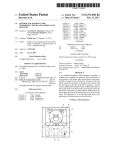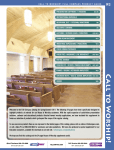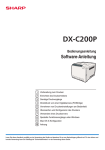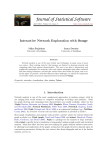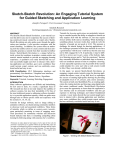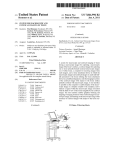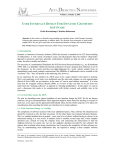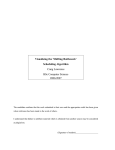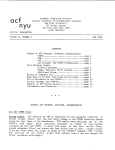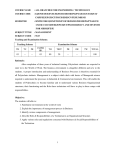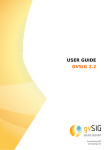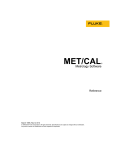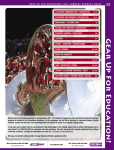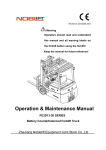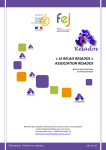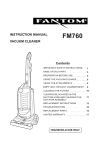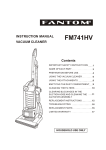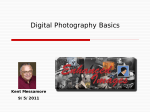Download Sections of a presentation having user
Transcript
USOO8108777B2 (12) Unlted States Patent (10) Patent N0.: Penner et a]. (45) Date of Patent: (54) SECTIONS OF A PRESENTATION HAVING , , 7/2007 Karasawa (US); Shawn Vlllaron, San Jose, CA (US); Dachuan Zhang, Sunnyvale, CA 7,299,418 B2 7,363,581 B2 11/2007 Dieberger 4/2008 Parks (Us) 7,392,475 B1 6/2008 Leban 7,493,561 B2 2/2009 Sareen gr;le (73) Assignee: Microsoft Corporation, Redmond, WA ( US 1 ur ong et a . 7,246,317 B2 (75) Inventors: Nathan Penner, Mountain View, CA Notice: Jan. 31, 2012 1131011 - USER DEFINABLE PROPERTIES (*) US 8,108,777 B2 (continued) ) FOREIGN PATENT DOCUMENTS Subject to any disclaimer, the term of this JP 2001-022257 patent is extended or adjusted under 35 1/2001 (Continued) U.S.C. 154(b) by 289 days. OTHER PUBLICATIONS (21) Appl.No.: 12/189,583 (22) Filed; International Search Report mailed Nov. 30, 2009, in PCT Applica Aug_ 11, 2008 (65) Prior Publication Data US 2010/0037140 A1 (51) Int. Cl. G06F 3/00 Cl. ...... (58) tion No. PCT/US2009/046529. (commued) Feb. 11, 2010 Primary Examiner * Tadeese Hailu (74) Attorney, Agent, or Firm * Merchant & Gould PC. (2006.01) (57) ...... ...... .. In general, Fleld 0fC1a_551?cat10n seareh ~~~~~~~~~ ~~ 715/73m732 see apphcanon ?le for complete searCh hlstOI'Y_ (56) sections includes zero or more slides of the electronic slide presentation. In addition to the slides associated With each U.S. PATENT DOCUMENTS A A A A 11/1996 12/1999 3/2000 10/2000 section, each of the sections is associated With one or more Liaw Bretschneider Bretschneider Bretschneider 6,369,835 B1* 4/2002 6,396,500 B1* 5/2002 Qureshiet a1. .............. .. 345/473 6,473,749 B1 6,738,075 B1* 6,819,338 B2 6,834,371 B1 properties having values that can be de?ned by an author of the presentation. Because the values of the properties of the sections are user-de?nable, these properties may, in some implementations of these techniques, enable the author of the presentation to use the sections in ways not possible in pre Lin ............................. .. 715/726 10/2002 Smith 5/2004 sentation applications that merely use sections as a means of Torres et a1. ................ .. 715/723 grouping thumbnail images of slides for navigation among 11/2004 Heasman 12/2004 Jensen 6,938,032 B1* 8/2005 7,073,127 B2 7/2006 Zhao disclosure describes techniques that employ user-de?ned values of properties of sections of an electronic presentation. As described herein, a user may con?gure a presentation to include a plurality of sections. Each of the References Clted 5,572,644 6,008,807 6,041,333 6,128,629 ABSTRACT slides in an authoring interface. Heath et a1. ......................... .. 1/1 17 Claims, 9 Drawing Sheets ,40 ACCESS SLIDESHOW FILE I ,42 GENERATE GRAPHICAL INTERFACE I DISPLAY GRAPHICAL INTERFACE 46 RECEIVE INPUT RELATED TO PROPERTY OF SLIDESHOW S ECTION I PERFORM ACTION USING PROPERTY OF SLIDESHOW S ECTIO N ,48 US 8,108,777 B2 Page 2 U.S. PATENT DOCUMENTS 7,526,726 B1* 4/2009 7,546,533 B2 7,590,939 B2 6/2009 Sareen 9/2009 Sareen 7,743,331 B1* 7,882,565 B2 * 6/2010 2/2011 2001/0040592 A1 2002/0001106 A1* 2002/0138389 2002/0164151 2002/0174085 2003/0101043 2003/0122863 2003/0142145 A1 A1 A1 A1 A1 A1 2003/0160814 A1* Dontcheva et al., v4v.‘ a View for the Vlewer, © 2005 AIGA, cover Skwarecki et al. ......... .. 715/731 Lan ............................. .. 358/474 9/2002 Martone 11/2002 Jasinschi 11/2002 Nelson Presentations, USIST’06, Oct. 15-18, 2006, © 2005 ACM 1-59593 313-1/06/0010; 10 pages, http://research.microsoft.com/~sdrucker/ papers/fp21 4 -DruckerFinalSmall .pdf. Grass Roots Software FREEPATH-EDU Nonlinear Presentation Software, accessed website Aug. 14, 2008,3 pages; http://www. fullcompass.com/product/233150.html. 5/2003 Boegelund Moscovich et al., Customizable Presentations, accessed website 7/ 2003 Dieberger et al. Aug. 14, 2008, 5 pages; http://www.cs.brown.edu/people/tm/papers/ 7/ 2003 Bennett cpresentations.pdf. 8/2003 Photodex Corporation, ProShow Producer Feature Overview, © 2008, 2 pages; http://www.photodex.com/products/producer/fea Brown ........................ .. 345/732 2003/0222890 A1 12/2003 Salesin et al. 2003/0222900 A1* 12/2003 Schramm-Apple et al. .. 345/730 2003/0231202 A1* 12/2003 2004/ 000 1 106 A1 2004/0015595 A1 v4v.pdf. Drucker et al., Comparing and Managing Multiple Versions ofSlide Fleischer et al. ............ .. 715/731 Collins et al. ................. .. 726/27 11/2001 Foreman 1/2002 page plus 8 pages; http://research.microsoft.com/~sdrucker/papers/ Parker et al. ................ .. 345/730 tures.html. University of Maryland, CounterPoint: A Zooming Presentation Tool, accessed website Aug. 14, 2008, 2 pages; http://www.cs.umd. 1/ 2004 Deutscher 1/2004 Lin 2004/ 0027370 A1 2/2004 Jaeger edu/hcil/counterpoint. 2004/0071453 A1* 2004/0113934 A1* 4/2004 6/2004 ZuiPrezi Nonlinear Presentation Editor, accessed website Aug. 14, 2008, 3 pages; http://test.2uipreZi.kibu.hu/. “Content Applications,” Products-Content Applications accessed at Valderas ..................... .. 386/125 Kleinman et al. .......... .. 345/732 2004/0125128 A1 7/2004 Chang 2004/0128691 A1* 7/2004 Egawa et al. ................. .. 725/88 2005/0138570 A1 2005/0246642 A1* 6/2005 Good et al. 11/2005 Valderas et al. ............ .. 715/730 2005/0289453 A1 12/2005 Segal 2006/0067578 A1* 3/2006 Fuse ........................... .. 382/190 2006/0080610 A1* 2006/0259875 A1* 4/2006 Kaminsky 11/2006 Collins et al. 2006/0265659 A1* 11/2006 2006/0282759 A1 12/2006 Collins 2006/0294469 A1* 2007/0056045 A1 * 12/2006 3/2007 2007/0188520 A1 2007/0294612 A1 . 715/730 . 715/853 Collins et al. ............... .. 715/732 Sareen et al. ............... .. 715/730 Collins et al. ................. .. 726/27 8/2007 Finley 12/2007 Drucker et al. 2008/0070218 A1* 2008/0189616 A1* 2009/0044117 A1* 3/2008 Ahl et al. .................... .. 434/322 8/2008 Coulomb et al. .. . 715/732 2/2009 Vaughan et al. ............ .. 715/716 2010/0031152 A1 2010/0037140 A1 2/2010 Villaron 2/2010 Penner FOREIGN PATENT DOCUMENTS W0 W0 W0 2006-124140 WO 2009/087999 11/2006 7/2009 OTHER PUBLICATIONS International Search Report mailed Jan. 29, 2010, in PCT Application No. PCT/US2009/051090. U.S. Appl. No. 12/ 184,174, entitled “Creation and Navigation of In?nite Canvas Presentation” ?led Jul. 31, 2008 of record. Kan, Min-Yen, SlideSeer: A Digital Library of Aligned Document and Presentation Pairs, Copyright 2006, 10 pages, http://www.comp. nus.edu.sg/~kanmy/papers/jcd12004.pdf. Keynote ’08 User’s Guide, Apple Inc. © 2008, 204 pages, http:// manuals.info.apple.com/en/Keynote08iUserGuide.pdf. Welcome to PowerPoint 2007, accessed 2008, 20 pages, http://www. computerbook.nl/pdf/9780470040591.pdf. Deneba Systems, Inc., Canvas Tips and Techniques, © 1995-2002, 9 pages; http://www.acdamerica.com/support-canvas/tutorials/pre sentation.pdf. http://web.archive.org/web/20030810211219/www.documentum. com/products/contentia; accessed on Aug. 10, 2003, 2 pages. “Delivering format transformation and analysis for all content,” EMC Documentum Content Transformation Services, Copyright 2006, 4 pages. “Microsoft Of?ce Picture Manager Basics” Nov. 8, 2006, 4 pages. “Microsoft Of?ce Picture Manager,” Microsoft Of?ce Picture Man ager accessed at: http://en.wikipedia.org/wiki/MicrosoftiOf?cei PictureiManager; accessed on Dec. 13, 2007, 2 pages. “SpanSoft,” Software from SpanSoft at Download-By.Net, copyright 2006, 4 pages. “What is Slide Librarian,” Slide Librarian, Current Version 2.4; accessed at: http://www.spansoft.org/slideirt.htm; accessed on Dec. 7, 2007, 3 pages. “CounterPoint: A Zooming Presentation Tool” accessed at: http:// web.archive.org/web/20050205082738/www.cs.umd.edu/hcil/ counterpoint/; accessed on Jan. 25, 2011, 3 pages. EP Supplemental Search Report in EP Appln. No. 098033129, mailed Jul. 7, 2011, 6 pages. Gallegos et al.; “CounterPoint User Manual” downloaded from archive Org 2005 capture, http://web.archive.org/web/ 20050205082738/www.cs.umd.edu/hcil/counterpoint/; 21 pages. Good et al.; “CounterPoint: Creating Jazzy Interactive Presenta tions”iHCIL Tech Report #2001-03, 9 pages. International Search Report in PCT Appln. No. PCT/US2006/ 17725, mailed Jul. 5, 2007, 8 pages. Microsoft Releases First Beta of “Of?ce 11”: Next Version of Of?ce to Connect People, Information and Business Processes, Oct. 2, 2002, 1 page. Non-Final Of?ceAction in US. Appl. No. 12/184, 174, mailed Feb. 4, 2011, 19 pages. Wempen, F., “PowerPoint 2007 Bible”; Feb. 27, 2007, excerpt, 27 pages. * cited by examiner US. Patent Jan. 31, 2012 Sheet 1 019 US 8,108,777 B2 COMPUTING DEVICE 2 STORAGE MEDIUM Q GRAPHICAL INTERFACE 2-2 SLIDESHOW FILE SLIDESHOW APPUCATION Q 22 i < ,6 > i PROCESSING UNIT 4 < I i INPUT DEVICE I > INTERFACE OUT P UT INTERFACE 12 1—4 T l T l INPUT DEVICE OUTPUT DEVICE 1_6 E FIG. 1 US. Patent Jan. 31, 2012 Sheet 2 0f9 US 8,108,777 B2 ,40 ACCESS SLIDESHOW FILE l r42 GENERATE GRAPHICAL INTERFACE l ,44 DISPLAY GRAPHICAL INTERFACE I r46 RECEIVE INPUT RELATED TO PROPERTY OF SLIDESHOW SECTION l ,48 PERFORM ACTION USING PROPERTY OF SLIDESHOW SECTION FIG. 2 US. Patent Jan. 31, 2012 Sheet 4 0f9 US 8,108,777 B2 [- 26 P?nt Printer: r100 \\App2\Printer2 iV |_____; Print Sections: ,102 All Slideshow Sections Electrical Principals Capacitance Ohm's Law US. Patent Jan. 31, 2012 Sheet 5 0f9 US 8,108,777 B2 [—26 Select Presented Sections Sections: [1 1 0 Electrical Principals 112A 1 1ZB-\ Capacitance 11zc'\\/ Ohm’s Law 0 OK DC J US. Patent Jan. 31, 2012 US 8,108,777 B2 Sheet 6 0f 9 “93c:oa5u0m m.>2:EEwt.wE QEm m.mwasE3.m:2o> c585mhuO:e M33250 .OEo 2:. :.85 m womtai ANwucmzuamo [email protected] =Ao2uc.wiaom u US. Patent Jan. 31, 2012 Sheet 7 0f9 US 8,108,777 B2 [- 26 Select Access Control Data for section “Ohm’s Law” Users: r1 50 Hillary John David Trevor 154A Rights: ' {152 View [ OK ) [ Cancel ) FIG. 7 US. Patent Jan. 31, 2012 Sheet 9 0f9 US 8,108,777 B2 [— 190 STORAGE MEDIUM 1_9_3_ SLIDESHOW FILE 1% NETWORK 29.12 COMPUTING DEVICE COMPUTING DEVICE 12.2. 12!. FIG. 9 US 8,108,777 B2 1 2 SECTIONS OF A PRESENTATION HAVING USER-DEFINABLE PROPERTIES properties during presentation of the presentation may, for example, include the ability to view names of sections of a presentation during presentation of the presentation and navi BACKGROUND gating to a ?rst slide in a section. BRIEF DESCRIPTION OF THE DRAWINGS Electronic presentations are used in a variety of contexts for conveying information. For example, a businessperson may use an electronic slide presentation to convey informa FIG. 1 illustrates an example computing device. FIG. 2 illustrates an example operation that instructions of a presentation application may cause a processing unit of the tion about business performance. In another example, a teacher may use an electronic slide presentation to teach a lesson. computing device to perform. FIG. 3 illustrates an example graphical interface generated by the presentation application for authoring a presentation. FIG. 4 illustrates an example graphical interface generated by the presentation application for printing slides in the pre Presentation applications executing on personal computers are used to author and present electronic presentations. A typical presentation application presents an authoring inter face that enables a user to edit slides in a presentation. The authoring interface may include a primary pane and a navi gation pane. The primary pane contains an editable slide in the presentation. The navigation pane may include a series of thumbnail images of each slide in the presentation. A thumb nail image of a slide is a smaller version of the slide. A user of the presentation application can click on a thumbnail image of a slide to cause the primary pane of the authoring interface to display the slide for editing. Electronic slide presentations may include a large number of slides and may contain information about several topics. sentation. FIG. 5 illustrates an example graphical interface generated by the processing unit to select sections to include in a pre 20 sentation of the presentation. FIG. 6 illustrates an example graphical interface generated by the processing unit for presenting the presentation. FIG. 7 illustrates an example graphical interface generated by the processing unit for de?ning access control data prop 25 For example, a physics teacher may use an electronic slide presentation to teach a lesson that includes slides about resis erties of a section of the presentation. FIG. 8 illustrates a sixth example version of graphical interface 26 generated by processing unit 4 for sorting slides. tance, slides about capacitance, and slides about an upcoming FIG. 9 illustrates an example system in which multiple computing devices simultaneously access a presentation ?le exam. 30 stored in a storage medium accessible by a network. SUMMARY DETAILED DESCRIPTION This Summary is provided to introduce a selection of con cepts in a simpli?ed form that are further described below in the Detailed Description. This Summary is not intended to identify key features or essential features of the claimed sub In general, this disclosure describes techniques that 35 electronic presentation. In the following description, various ject matter, nor is it intended to be used to limit the scope of the claimed subject matter. In general, this disclosure describes techniques that employ user-de?ned values of properties of sections of an electronic presentation. As described herein, a user may con ?gure a presentation to include a plurality of sections. Each of employ user-de?ned values of properties of sections of an examples are described. It should be appreciated that these examples are provided for purposes of explanation and not as 40 express or implied limitations on the scopes of the claims. FIG. 1 illustrates an example computing device 2. Com puting device 2 may be a wide variety of different types of the sections includes zero or more slides of the electronic physical computing devices. For example, computing device slide presentation. In addition to the slides associated with 2 may be a personal computer, a laptop computer, a tablet each section, each of the sections is associated with one or more properties having values that can be de?ned by an mobile telephone, a network telephone, a television set top computer, a server computer, a mainframe computer, a author of the presentation. Because the values of the proper ties of the sections are user-de?nable, these properties may, in some implementations of these techniques, enable the author of the presentation to use the sections in ways not possible in box, a personal media player, or another type of computing device. Furthermore, computing device 2 may implemented presentation applications that merely use sections as a means computing devices. In another example, computing device 2 may be a grid computing system. As illustrated in the example of FIG. 1, computing device 2 comprises a processing unit 4 that is capable of executing of grouping thumbnail images of slides for easy navigation among slides in an authoring interface. As described below, the properties of a section may include, for example, a title of the section, a name of an author of the section, a set of access control data that speci?es rights of users to perform actions with respect to the section, and other properties. The properties of sections may be used dur ing authoring of the presentation or during presentation of the presentation. The uses of such properties during authoring of a presentation may include, for example, the ability to conceal or reveal thumbnail images of slides in a section by clicking as two or more physically separate “boxes.” For example, computing device 2 may be a cluster of two or more physical instructions. Processing unit 4 may be implemented as a set of integrated circuits that includes at least one integrated circuit. In one example implementation, processing unit 4 is a Core 2 processor manufactured by Intel Corporation of Santa Clara, Calif. In other example implementations, processing unit 4 is implemented as a plurality of integrated circuits distributed among several physical devices. The example of FIG. 1 also illustrates that computing print the slides in the section, the ability to create a hyperlink device 2 comprises a communication link 6 that enables pro cessing unit 4 to communicate with a storage medium 8. Communication link 6 may be a variety of different types of to a section of a presentation, the ability to associate search able keywords with sections, and other uses. The uses of such communications link, including a front-side bus, a Hyper Transport link, an Intel QuickPath Interconnect, an Acceler on a title of the section, the ability to reorder sections using titles of the sections, the ability to use the name of a section to US 8,108,777 B2 3 4 ated Graphics Port bus, a computer network link (e.g., one or more Ethernet links, ?ber optic links, etc.), a PCI link, or another type of link. having a user-de?nable value and that is associated with zero or more sequential or non-sequential slides of the presenta tion. Each set of section data identi?es a set of slides associ ated with a section and a user-de?ned value of a property of the section other than the set of slides included in the section. As discussed below, the property of the section may be a Storage medium 8 is capable of storing instructions that are readable and executable by processing unit 4. Storage medium 8 may be a wide variety of different types of com puter-readable storage media. For example, storage medium variety of different properties and that a set of section data may include several user-de?ned values of properties of a section. For example, a ?rst set of section data may contain data that directly represents six slides included in a ?rst sec tion and may contain data that indicates that the name of the ?rst section is “Section 1.” Further, in this example, a second set of section data in presentation ?le 20 may contain data that 8 may be implemented as one or more random access memory units, one or more read-only memory units, magnetic disks, optical disks, magnetic tapes, ?ash memory units, or other types of storage media. It should be appreciated that the term “storage medium” refers to a collection of one or more stor age media units or one or more types of storage media. For instance, some data in storage medium 8 may be physically directly represents four slides and may contain data that indi stored on a magnetic tape and some data in storage medium 8 may be physically stored on a magnetic disk. cates that the name of the second section is “Section 2.” In this In the example of FIG. 1, computing device 2 includes a 9 and the second section may include slides 2, 4, 8, and 10. Presentation ?le 20 may include a wide variety of different types of data structures that embody the sets of section data. For example, presentation ?le 20 may include an extensible markup language C(ML) data structure for each set of section data. In another example, presentation ?le 20 may include binary data structures that represent each set of section data. In another example, presentation ?le 20 may include a set of section data that identi?es the ?rst set of slides and identi?es the data that speci?es the user-de?ned value of the property of communication link 10 that enables processing unit 4 to com municate with an input device interface 12 and an output device interface 14. Communication link 10 may be a variety of different types of communications link, including a front side bus, a HyperTransport link, an Intel QuickPath Intercon nect, an Accelerated Graphics Port bus, a computer network link (e.g., one or more Ethernet links, ?ber optic links, etc.), a PCI link, or another type of link. Input device interface 10 facilitates communication from an input device 16. Output example, the ?rst section may include slides 1, 3, 5, 6, 7, and 20 25 device interface 14 facilitates communication with an output the ?rst section by specifying a link to a third set of section device 18 that is capable of outputting information to the real world. Input device interface 12 and output device interface 14 may be implemented in a variety of ways. For instance, input device interface 12 and/or output device interface 14 may be implemented as a Universal Serial Bus (U SB) inter data contained in a second presentation ?le. In this example, the third set of section data identi?es the ?rst set of slides and face card, a serial bus card, a network interface (e.g., an Ethernet card, a WiFi adapter, a WiMax adapter, etc.) or another type of physical input device interface. In some 30 35 instances, the functionality of input device interface 10 and the functionality of output device interface 12 may be imple mented by a single physical card. Input device 16 may be wide variety of different types of devices. For example, input device 16 may be a mouse, a trackball, a touch-sensitive screen, a keyboard, a keypad, or 40 In addition to presentation ?le 20, storage medium 8 stores a presentation application 22. Presentation application 22 may be similar in some respects to presentation applications such as the Microsoft POWERPOINT® presentation graph ics program sold by Microsoft Corporation of Redmond, Wash., the KEYNOTE® slide presentation software sold by Apple Corporation of Cupertino, Calif., the OpenOf?ce Impress slide presentation software provided by OpenOf?ce another type of input device. .org, and the GOOGLE APPS® slide presentation application Output device 18 may also be a wide variety of different types of devices. For example, output device 18 may be a visual display unit such as a cathode ray display screen, a identi?es data that speci?es the user-de?ned value of the property of the ?rst section by containing data that directly represents the ?rst set of slides and by containing data that directly represents the user-de?ned value of the property of the ?rst presentation. 45 liquid crystal display (LCD) screen, a light-emitting diode provided by Google, Inc. of Mountain View, Calif. In one example implementation, presentation application 22 comprises a set of instructions that are executable by processing unit 4. When a user 24 wants to interact with the (LED) array, a plasma screen, or another type of device that is capable of outputting information to the real world. Process electronic presentation represented by presentation ?le 20, ing unit 4 may present information on output device 18 in a user 24 may use input device 16 to instruct computing device variety of ways. For example, processing unit 4 and output 50 computing device 2. In this example, a digital visual interface cable, or another type of physical video connector cable, may connect the output device interface 14 and output device 18. In this example, processing unit 4 may send instructions regarding an image to output device interface 14 and output device interface 14 may send signals to output device 18 to 2 to begin executing the instructions of presentation applica tion 22. For example, user 24 may instruct computing device device interface 14 may be connected to a motherboard of 2 to begin executing instructions of presentation application 22 by using a mouse to select an icon displayed on output device 18 that represents presentation application 22. In 55 another example, user 24 may instruct computing device 2 to begin executing instructions of presentation application 22 by using a keyboard to select an icon representing presentation display the image. In another example, processing unit 4 may present information on output device 18 by transmitting ?le 20. information over a network to a computing device that causes 60 of presentation application 22, the instructions cause process ing unit 4 to access presentation ?le 20. Upon accessing When processing unit 4 begins executing the instructions output device 18 to display an image based on the transmitted information. Storage medium 8 stores a presentation ?le 20 that repre sents an electronic presentation. Presentation ?le 20 contains at least one set of section data. Each set of section data in presentation ?le 20 de?nes a section. A “section” is a logical unit of an electronic presentation that has at least one property presentation ?le 20, the instructions of presentation applica 65 tion 22 cause processing unit 4 to generate a graphical inter face 26 in storage medium 8. When processing unit 4 gener ates graphical interface 26, processing unit 4 uses the values of the properties of the sections of the presentation. Graphical interface 26, when displayed on output device 18 enables a US 8,108,777 B2 5 6 user 24 to interact with an electronic presentation that instructions of presentation application 22 cause processing unit 4 to generate graphical interface 26 such that graphical includes the slides in each of the sections de?ned by the sets of section data included in presentation ?le 20. After causing interface 26 includes a primary pane 70 and a navigation pane 72. Primary pane 70 contains an editable slide 76 in the presentation. Navigation pane 72 includes a series of thumb processing unit 4 to generate graphical interface 26, the instructions of presentation application 22 cause processing begins executing the instructions of presentation application nail images 78A through 78D (collectively, “thumbnail images 78”) of slides in the presentation. In addition to thumbnail images 78, navigation pane 72 includes the values of the title properties 80A-80C (collectively, “titles 80”) of the sections of the presentation. Thumbnail images of slides 22, the instructions cause processing unit 4 to access presen within a section are shown below the value of the title prop tation ?le 20 (40). In other words, the instructions cause processing unit 4 to retrieve some or all of presentation ?le 20 thumbnail images 78A and 78B are shown below the title unit 4 to display graphical interface 26 on output device 18. FIG. 2 illustrates a ?rst example operation that instructions of presentation application 22 may cause processing unit 4 of computing device 2 to perform. When processing unit 4 erty of the section. For instance, in the example of FIG. 3, from storage medium 8. As described above, presentation ?le “Electrical Properties” indicating that the slides represented 20 contains at least one set of section data. Each set of section by thumbnail images 78A and 78B are within a section having data identi?es a set of zero or more slides included in a section the title property “Electrical Properties.” Similarly, thumbnail and a user-de?ned value of a property of the section other than images 78C and 78D are shown below the title “Ohm’ s Law” the set of slides included in the section. For example, presen tation ?le 20 may contain: (i) a ?rst set of section data that de?nes a ?rst section, the ?rst set of section data identifying indicating that the slides represented by thumbnail images 20 a ?rst set of slides and identifying data that speci?es a user de?ned value of a property of the ?rst section other than the ?rst set of slides, and (ii) a second set of section data that de?nes a second section, the second set of section data iden tifying a second set of slides and identifying data that speci 78C and 78D are within the section having the title property “Ohm’s Law.” The example interface in FIG. 3 also illustrates that a ?rst section may be a child section of a second section. When a 25 ?rst section is a child section of a second section, all slides in the ?rst section are slides in the section, but all slides in the second section are not necessarily slides in the ?rst section. In ?es a user-de?ned value of a property of the second section other than the second set of slides. the example of FIG. 3, the section having the title property After the instructions of presentation application 22 cause processing unit 4 to access presentation ?le 20, the instruc tions of presentation application 22 cause processing unit 4 to generate graphical interface 26 using at least one user-de?ned value of a property of one of the sections (42). Continuing the property “Electrical Properties.” The fact that the section “Ohm’s Law” is a child section of the section having the title having the title property “Ohm’ s Law” is a child section of the 30 example cited in the previous paragraph, the instructions of presentation application 22 may cause processing unit 4 to generate graphical interface 26 using the value of property of 35 the ?rst section and the value of the property of the second section. Once processing unit 4 generates graphical interface 26, the instructions of presentation application 22 cause pro cessing unit 4 to display graphical interface 26 on output device 18 (44). As mentioned above, graphical interface 26 is designed to 40 indentation of the thumbnail images of the slides in the sec tion having the title property of “Ohm’s Law” relative to slides in the section having the title property “Electrical Prop erties.” The example interface in FIG. 3 also includes conceal icons 82A and 82B (collectively, “conceal icons 82”). When graphical interface 26 is displayed on output device 18, user 24 may use input device 14 to select one of conceal icons 82. When user 24 selects conceal icon 82A, processing unit 4 receives section concealment input that indicates that user 24 wants to conceal the thumbnail images of slides in the section enable user 24 to interact with a presentation that includes slides in the sections contained in presentation ?le 20. Accordingly, when output device 18 displays graphical inter face 26, the instructions of presentation application 22 enable section having the title property “Electrical Properties” is demonstrated visually by the indentation of the title “Ohm’s Law” relative to the title “Electrical Properties” and the erty of the section (48). having the title property “Electrical Properties.” Note that in the example of FIG. 3, the slides in the section having the title property “Electrical Properties” include all slides in the sec tion having the title property “Ohm’s Law” and all slides in the section having the title property “Capacitance.” In response to the section concealment input, the instructions of presentation application 22 cause processing unit 4 to update graphical interface 26 such that graphical interface 26 does not include any thumbnail images of slides in the section The instructions of presentation application 22 may cause processing unit 4 to generate graphical interface 26 in a wide having the title property “Electrical Properties” (i.e., thumb nail images 78A, 78B, 78C, and 78D). The instructions of 45 processing unit 4 to receive input related to a property of a section in the presentation (46). For example, the instructions of presentation application 22 may enable processing unit 4 to receive mouse movement and mouse click input. In response to the input, the instructions of presentation application 22 50 cause processing unit 4 to perform an action using the prop variety of ways, thereby enabling a wide variety of possible 55 ways that user 24 can interact with the presentation. Further presentation application 22 may also cause processing unit 4 to update graphical interface 26 such that graphical interface more, because the instructions of presentation application 22 may cause processing unit 4 to generate graphical interface 26 26 does not include the titles of any sections that are child in a wide variety of ways, processing unit 4 may be receive a Properties” (i.e., “Capacitance” and “Ohm’s Law”). The wide variety of inputs in step 46 and may perform a wide variety of actions in response to these inputs in step 48. Some of the potential ways of generating graphical interface 26 to enable speci?c types of interaction are summarized with ref sections of the section having the title property “Electrical 60 instructions of presentation application 22 also cause pro cessing unit 4 to display the updated graphical interface on output device 18. The example interface in FIG. 3 also includes a reveal icon 84. The instructions of presentation application 22 may cause 65 processing unit 4 to display a reveal icon next to a title of a erence to FIGS. 3-8. In a ?rst example, presentation ?le 20 includes sets of section data that contain user-de?ned values of title properties of the sections of the presentation. Referring to FIG. 3, the section in which the thumbnail image of slides in the section are concealed. When user 24 selects reveal icon 84, process US 8,108,777 B2 7 8 ing unit 4 receives section reveal input that indicates that user 24 wants to reveal the thumbnail images of slides in the section having the title property “Capacitance.” In response to the selected section. The copy command input may take the the section reveal input, the instructions of presentation appli user 24 dragging the title of the section to a location and “dropping” the title of the section at a location where the section is to be added. form of user 24 clicking on the title of a section of the pre sentation and the paste command input may take the form of cation 22 cause processing unit 4 to update graphical interface 26 such that graphical interface 26 includes thumbnail images of slides in the section having the title “Capacitance.” The instructions of presentation application 22 then cause pro cessing unit 4 to display the updated graphical interface on output device 18. FIG. 4 illustrates a second example version of graphical interface 26 generated by processing unit 4 for printing slides in the presentation. In the example of FIG. 4, graphical inter face 26 is a print dialog window. The instructions of presen tation application 22 may cause processing unit 4 to display The example interface of FIG. 3 also includes an auto update ?eld 86 within slide 76. Auto-update ?eld 86 contains the value of the title property of the section to which slide 76 graphical interface 26 in response to an input from user 24 that indicates that user 24 wants to print slides in the presen belongs. In the example of FIG. 3, slide 76 belongs to the tation. As illustrated in the example of FIG. 4, graphical section having the title “Ohm’s Law.” When user 24 elects to interface 26 includes a “Printer” drop box 100 that enables user 24 to select a printer with which to print the slides of the change the value of the title property of the section to which slide 76 belongs, processing unit 4 receives title change input presentation. Furthermore, as illustrated in the example of FIG. 4, graphical interface 26 includes a “Print Sections” drop box 102. User 24 may interact with “Print Sections” drop box that indicates a new title for the section. In response to the title change input, the instructions of presentation application cause processing unit 4 to update the value of the title prop erty displayed in auto -update ?eld 86. It should be understood that other auto-update ?elds may contain values of other properties of sections. For instance, an auto-update ?eld in a slide of a section may contain the name speci?ed by an “author” property of the section. In this instance, if user 24 elected to change the value of the “author” property of the 20 with “Print Sections” drop box 102, processing unit 4 may 25 “OK” button 104. When user 24 uses input device 14 to select “OK” button 104, processing unit 4 instructs the printing device indicated by “Printer” drop box 100 to print the slides 30 During presentation of the presentation, user 24 may select link 88 in order to jump to the sequentially ?rst slide in a presentation selection referenced by link 88. In the example in the selected sections. FIG. 5 illustrates a third example version of graphical interface 26 generated by processing unit 4 that enables user 24 to select sections to display in a presentation of the pre sentation. As illustrated in the example of FIG. 5, graphical of FIG. 3, selection on link 88 may cause processing unit 4 to display the sequentially ?rst slide in the section titled receive section selection input that indicates one or more of the sections as selected sections. Furthermore, as illustrated in the example of FIG. 4, graphical interface 26 includes an section, the instructions of presentation application 22 cause processing unit 4 to automatically update the name contained in the auto-update ?eld. The example interface of FIG. 3 also includes a link 88. 102 to indicate that user 24 wants to print slides in all sections of the presentation or that user 24 wants to print slides only in a selected section of the presentation. When user 24 interacts 35 “Capacitance.” interface 26 is a section selection dialog window. The instruc User 24 can use the example interface of FIG. 3 to interact tions of presentation application 22 may cause processing unit 4 to display graphical interface 26 in response to an input with the presentation in additional ways. For example, user 24 may use input device 14 to select a section by selecting the tions of the presentation to be displayed in a presentation of title (e.g., title 80C) of the section in navigation pane 72. from user 24 that indicates that user 24 wants to select sec 40 of presentation application 22 cause processing unit 4 to the presentation. In the example of FIG. 5, graphical interface 26 includes a list 110 of the values of the title properties of the When user 24 selects one of titles 80, processing unit 4 receives section selection input that indicates that user 24 has selected the section associated with the selected one of titles 80. In response to the section selection input, the instructions sections in the presentation. In addition, graphical interface 45 26 includes checkboxes 112A-112C (collectively, “check boxes 112”) next to each of the values of the title properties of the sections in the presentation. A checkmark in one of check update graphical interface 26 such that the thumbnail images boxes 112 next to a value of the title property of one of the of the slides in the selected section are visually differentiated from the thumbnail images of the slides in the non-selected the slides of the section are to be included in a presentation of sections. For example, the thumbnail images of the slides in the selected section may be visually differentiated from the thumbnail images of the slides in the non-selected sections by a thicker border around the thumbnail images of the slides in the selected section. When user 24 has selected a section, processing unit 4 may receive copy command input from user 24 and may subse sections indicates that a property of the section speci?es that 50 tion titled “Ohm’ s Law” are to be included in a presentation of the presentation and that the slides in the section titled “Capacitance” are not to be included in the presentation of the 55 quently receive paste command input from user 24. In response to the paste command input, the instructions of presentation application 22 cause processing unit 4 to copy to one of checkboxes 112, processing unit 4 receives section selection input that indicates that user 24 wants slides in the 60 section associated with the one of checkboxes 112 to be included in the presentation of the presentation. In response to the section selection input, processing unit 4 modi?es the value of property of the presentation selection to indicate that when the paste command input indicates a location in a sec ond presentation, the instructions of presentation application 22 may cause processing unit 4 to copy the set of presentation data that de?nes the selected section to a location in the second presentation. As a result, the second presentation includes the selected section, including the data identifying the slides in the selected section and values of properties of presentation. User 24 may use input device 14 to add or remove check marks from checkboxes 112. When user 24 adds a checkmark the presentation data that de?nes the selected section to a location indicated by the paste command input. For instance, the presentation. In the example of FIG. 5, there are check marks in checkboxes 112A and 112B, indicating that slides in the section titled “Electric Properties” and slides in the sec the slides of the section are to be included in presentations of 65 the presentation. Later, processing unit 4 may receive input that indicates that user 24 wants to present the presentation. In response to US 8,108,777 B2 10 this input, the instructions of presentation application 22 may user has a right to perform an action with respect to the ?rst section and the value of the property of the second section cause processing unit 4 to use the value of the property of the selected section to determine whether to display the slides of represents a second set of access control data that speci?es that the user does not have the right to perform the action with respect to the second section. the selected section. Subsequently, the instructions of presen tation application 22 may cause processing unit 4 to generate a presentation graphical interface that includes a slide of the selected section when it is determined that the value of the property of the selected section indicates that the slides of the selected section are to be displayed in the presentation of the Subsequently, processing unit 4 may receive a request from a user to perform an action (e.g., view or edit a slide) with respect to a section in the presentation. In response to receiv presentation. The instructions of presentation application 22 may then cause processing unit 4 to display the presentation graphical interface on output device 18. In this way, sections can be skipped seamlessly during presentation of the presen tation. FIG. 6 illustrates a fourth example version of graphical interface 26 generated by processing unit 4 for presenting the presentation. As illustrated in the example of FIG. 6, graphi cal interface 26 includes slide 76 (FIG. 3). Furthermore, graphical interface 26 shows a pointer 130 controlled by user 24 using input device 14. User 24 may use input device 14 to 20 ing the request from the user to perform the action with respect to the section of the presentation, the instructions of presentation application 22 cause processing unit 4 to use these properties of the section to determine whether the user has a right to perform the action with respect to the section. If the user has the right to perform the action with respect to the section, the instructions of presentation application 22 cause processing unit 4 to perform the action. If the user does not have the right to perform the action with respect to the section, the instructions of presentation application 22 cause process ing unit 4 to deny the request to perform the action. FIG. 8 illustrates a sixth example version of graphical cal interface 26 includes a menu 132 that lists the values of the interface 26 generated by processing unit 4 for sorting slides. As illustrated in the example of FIG. 8, graphical interface 26 includes title bars 170A, 170B, 170C, and 170D (collectively, “title bars 170”). Title bars 170 include the values of title properties of sections in a presentation. In the example of FIG. 8, title bar 170A indicates that “Introduction” is the title properties of the sections of the presentation. User 24 value of a title property of a ?rst section of a presentation, title may then position pointer 130 to indicate that user 24 wants to skip to a particular section of the presentation. When user 24 indicates that user 24 wants to skip to a selected section of the bar 170B indicates that “Q2 Sales Report” is the value of a title property of a second section of the presentation, title bar 170C indicates that “Q3 Sales Outlook” is the value of a title property of a third section of the presentation, and title bar 170D indicates that “Q3 Expenses Outlook” is the value of a title property of a fourth section of the presentation. Title bars 170 also indicate how many slides are in each of the sections indicate that user 24 wants to skip to a different section of the presentation. For example, user 24 may press a right mouse button of input device 14. When user 24 indicates that user 24 wants to skip to a different section of the presentation, pro cessing unit 4 updates graphical interface 26 such that graphi 25 30 presentation, processing unit 4 receives section selection input that indicates that user 24 wants output device 18 to display a sequentially ?rst slide in the selected section. In response to the section selection input, the instructions of presentation application 22 cause processing unit 4 to update graphical interface 26 such that graphical interface 26 includes an image of the sequentially ?rst slides in the selected section and causes processing unit 4 to display the updated graphical interface on output device 18. FIG. 7 illustrates a ?fth example version of graphical inter 35 (collectively, “icons 172”) that enable user 24 to conceal or reveal thumbnail images of slides. In the example of FIG. 8, 40 face 26 generated by processing unit 4 for de?ning access control data properties of a section of the presentation. In the example of FIG. 7, graphical interface 26 enables user 24 to select access control data for the section titled “Ohm’s Law.” Speci?cally, graphical interface 26 includes a “users” drop of the presentation. Title bars 170 include icons 172A, 172B, 172C, and 172D 45 box 150 that enables user 24 to select another user. For graphical interface 26 includes a set of thumbnail images 174A beneath title bar 170A that includes thumbnail images in the ?rst section of the presentation. In addition, in the example of FIG. 8, graphical interface 26 includes a set of thumbnail images 174B beneath title bar 170C that includes thumbnail images in the third section of the presentation. User 24 may conceal thumbnail images 174A by selecting icon 172A and may conceal thumbnail images 174B by instance, in the example of FIG. 7, user 24 may select users selecting icon 172C. User 24 may reveal a set of thumbnail named “Hillary,” “John,” “David,” or “Trevor.” In addition, images of the slides in the second section of the presentation by selecting icon 172B. Because the fourth section of the presentation does not include any slides, graphical interface 24 does not display any thumbnail images beneath title bar graphical interface 26 includes a list of rights 152. In the example of FIG. 7, list of rights 152 includes a right to view 50 slides in the section titled “Ohm’s Law” and a right to edit slides in the section titled “Ohm’s Law.” Furthermore, graphi 17 0D. User 24 may use this version of graphical interface 24 to cal interface 26 includes a checkbox 154A and a checkbox 154B. A checkmark in checkbox 154A indicates a property of the section titled “Ohm’s Law” has a value that speci?es that the user selected in “users” drop box 150 has the right to view slides in the section titled “Ohm’s Law.” A checkmark in checkbox 154B indicates a property of the section titled “Ohm’s Law” has a value that speci?es that the user selected in “users” drop box 150 has the right to edit slides in the section titled “Ohm’s Law.” User 24 may rede?ne the values organize slides of the presentation into sections. For example, 55 images 174A. User 24 may then drag the selected thumbnail 60 of these properties by clicking on checkbox 154A and/or checkbox 154B. It should be appreciated that values of these properties for a single user may differ among sections of the presentation. For instance, the value of the property of a ?rst section rep resents a ?rst set of access control data that speci?es that a user 24 may use input device 14 to select one of thumbnail 65 image of the slide to an area of graphical interface 26 beneath one of title bars 170. When user 24 has dragged the thumbnail image of the slide to the area of graphical interface 26 beneath one of title bars 170, the slide is removed from the ?rst section added to the section of the presentation associated with the title bar. For instance, user 24 drags the selected thumbnail image of the slide to an area of graphical interface 26 beneath title bar 170D, the slide is removed from the ?rst section and added to the fourth section. User 24 may interact with the presentation in a variety of ways by selecting title bars 170. For instance, by selecting US 8,108,777 B2 11 12 title bars 170, user 24 may change the values of the title data that de?nes a second section, the second set of section data identifying a second set of slides and identifying data that speci?es a user-de?ned value of a property of the second section other than the second set of slides. The method also properties of the sections of the presentation. In another instance, by selecting title bars 170, user 24 may add a set of keywords that enable a search engine to identify a section within the presentation. In each of these instances, when user 24 selects one of title bars 170, processing unit 4 receives comprises generating, at the computing device, a graphical interface using the value of the property of the ?rst section and the value of the property of the second section, the graphical input and the instructions of presentation application 22 cause processing unit 4 to perform an action in response. FIG. 9 illustrates an example system 190 in which multiple computing devices 192 and 194 simultaneously access a pre sentation ?le 196 stored in a storage medium 198 accessible by a network 200. In system 190, presentation ?le 196 may sentation that includes the slides in the ?rst set of slides and the slides in the second set of slides. In addition, the method comprises displaying the graphical interface on an output device. include a ?rst set of section data that de?nes a ?rst section and a second set of section data that de?nes a second section. be realized as a computing device comprising a processing Because the ?rst set of section data and the second set of unit that is capable of executing instructions, an output section data are logically distinct within presentation ?le 196, device, and a storage medium. The storage medium com prises a presentation ?le stored on a computer-readable stor interface enabling a user to interact with an electronic pre In another example, the techniques of this disclosure may a user of computing device 192 may edit slides in the ?rst section of the presentation at the same time that a user of age medium, the presentation ?le containing: (i) a ?rst set of computing device 194 is editing slides in the second section of the presentation. This may enable these users to work on the presentation in a collaborative fashion. 20 It is to be understood that the implementations described herein may be implemented by hardware, software, ?rmware, middleware, microcode, or any combination thereof. When the systems and/or methods are implemented in software, ?rmware, middleware or microcode, program code or code segments, they may be stored in a computer-readable storage medium, such as a storage component. A code segment may 25 readable storage medium also comprises instructions that, when executed by the processing unit, cause the processing represent a procedure, a function, a subprogram, a program, a routine, a subroutine, a module, a software package, a class, or any combination of instructions, data structures, or pro 30 interface enabling a user to interact with an electronic pre sentation that includes the slides in the ?rst set of slides and the slides in the second set of slides; and display the graphical 35 medium, the presentation ?le containing: (i) a ?rst set of 40 section data that de?nes a ?rst section, the ?rst set of section data identifying a ?rst set of slides, identifying data that speci?es a title of the ?rst section, and identifying data that example, magnetic disks, optical disks, or tape. Computer readable storage media may include volatile and nonvolatile, removable and non-removable media implemented in any method or technology for storage of information, such as computer readable instructions, data structures, program interface on the output device. In another example, the techniques of this disclosure may be realized as a computer-readable storage medium compris ing a presentation ?le stored on a computer-readable storage including memory sharing, message passing, token passing, network transmission, etc. Furthermore, it is to be understood that computing device 2 may have additional features or functionality. For example, computing device 2 may also include additional data storage devices (removable and/or non-removable) such as, for unit to: access the presentation ?le; generate a graphical inter face using the value of the property of the ?rst section and the value of the property of the second section, the graphical gram statements A code segment may be coupled to another code segment or a hardware circuit by passing and/or receiv ing information, data, arguments, parameters, or memory contents. Information, arguments, parameters, data, etc. may be passed, forwarded, or transmitted using any suitable means section data that de?nes a ?rst section, the ?rst set of section data identifying a ?rst set of slides and identifying data that speci?es a user-de?ned value of a property of the ?rst section other than the ?rst set of slides, and (ii) a second set of section data that de?nes a second section, the second set of section data identifying a second set of slides and identifying data that speci?es a user-de?ned value of a property of the second section other than the second set of slides. The computer 45 speci?es a user-de?ned value of a property of the ?rst section that represents a ?rst set of access control data that speci?es that the user has a right to perform an action with respect to the ?rst section, and (ii) a second set of section data that de?nes a second section, the second set of section data identifying a 50 second set of slides, identifying data that speci?es a title of the second section, and identifying data that speci?es a user de?ned value of a property of the second section that repre cessor or external to the processor, in which case it can be 55 user does not have the right to perform the action with respect to the second section. The computer-readable storage medium also comprises instructions that, when executed by a processing unit of a computing device, cause the processing modules, or other data. For a software implementation, the techniques described herein may be implemented with modules (e. g., procedures, functions, and so on) that perform the functions described sents a second set of access control data that speci?es that the herein. The software codes and instructions may be stored in computer-readable storage media and executed by proces sors. The memory unit may be implemented within the pro communicatively coupled to the processor via various means unit to access the presentation ?le. The instructions also cause as is known in the art. the processing unit to generate a graphical interface that dis plays the title of the ?rst section and the title of the second section. Furthermore, the instructions cause the processing These techniques may be realized in several ways. For example, these techniques may be conceptualized as a method for organizing slides of an electronic slide presenta tion. The method comprises accessing, with a computing 60 unit to receive a request from the user to perform the action with respect to the ?rst section. The instructions also cause the device, a presentation ?le stored on a computer-readable stor processing unit to, in response to receiving the request from age medium, the presentation ?le containing: (i) a ?rst set of the user to perform the action with respect to the ?rst section, determine that the second set of access control data speci?es that the user does not have the right to perform the action with section data that de?nes a ?rst section, the ?rst set of section data identifying a ?rst set of slides and identifying data that speci?es a user-de?ned value of a property of the ?rst section other than the ?rst set of slides, and (ii) a second set of section 65 respect to the second section; and perform the action with respect to the ?rst section. In addition, the instructions cause US 8,108,777 B2 14 13 the processing unit to receive a request from the user to in response to receiving the request from the user to perform the action With respect to the second section. Fur thermore, the instructions cause the processing unit to, in response to receiving the request from the user to perform the action With respect to the second section, determine that the perform the action With respect to the second section: determining, by the computing device, that the second set of access control data speci?es that the user does not have the right to perform the action With respect to the second section; and after determining that the user does not have the right to perform the action With respect to the second second set of access control data speci?es that the user does not have the right to perform the action With respect to the second section and deny the request to perform the action With respect to the second section. Although the subject matter has been described in lan guage speci?c to structural features and/or methodological acts, it is to be understood that the subject matter de?ned in the appended claims is not necessarily limited to the speci?c features or acts described above. Rather, the speci?c features section, denying, by the computing device, the request to perform the action With respect to the second section. 2. The method of claim 1, Wherein the presentation ?le contains a third set of section data, the third set of section data de?ning a third section of the electronic slide presentation, the third section of the electronic slide presentation not and acts described above are disclosed as example forms of implementing the claims. including any slides. We claim: 1. A method for organizing slides of an electronic slide presentation, the method comprising: accessing, by a computing device, a presentation ?le for the electronic slide presentation, the presentation ?le stored 20 input that indicates that the user wants the output device to display a sequentially ?rst slide in the sec on a computer-readable storage medium, the presenta tion ?le containing: a ?rst set of section data, the ?rst set of section data de?ning a ?rst section of the electronic slide presen 25 interface such that the graphical interface includes an 30 image of the sequentially ?rst slide in the second section; and displaying the updated graphical interface on the output device. 4. The method of claim 1, Wherein the method further sentation, the second set of section data identifying comprises: slides in the second section of the electronic slide presentation and identifying a user-de?ned title of the receiving, at the computing device, section concealment second section; generating, by the computing device, a graphical interface including the title of the ?rst section, thumbnail images input that indicates that the user wants to conceal the thumbnail images of the slides in the ?rst section; in response to receiving the section concealment input, updating, by the computing device, the graphical inter of the slides in the ?rst section, the title of the second section, and thumbnail images of the slides in the second face such that the graphical interface does not include any thumbnail images of the slides in the ?rst section; and displaying the updated graphical interface on the output device. 5. The method of claim 1, Wherein the method further section; and displaying the graphical interface on an output device: Wherein the ?rst set of section data identi?es a ?rst set of access control data, the ?rst set of access control data specifying that the user has a right to perform an action With respect to the ?rst section; ond section by selecting the title of the second section included in the graphical interface; in response to receiving the section selection input, updating, by the computing device, the graphical tation, the ?rst set of section data identifying slides in the ?rst section of the electronic slide presentation and identifying a user-de?ned title of the ?rst section, and a second set of section data, the second set of section data de?ning a second section of the electronic slide pre 3. The method of claim 1, Wherein the method further comprises: receiving, at the computing device, section selection 45 comprises: receiving, at the computing device, section selection input Wherein the second set of section data identi?es a second set of access control data, the second set of access con that indicates that the user has selected the ?rst section trol data specifying that the user does not have a right to by selecting the title of the ?rst section on the graphical perform the action With respect to the second section; and interface; 50 ing, by the computing device, the graphical interface Wherein the method further comprises: receiving, at the computing device, a request from the such that the thumbnail images of the slides in the ?rst section are visually differentiated from the thumbnail images of the slides in the second section; and user to perform the action With respect to the ?rst section; in response to receiving the request from the user to 55 perform the action With respect to the ?rst section: 6. The method of claim 5, further comprising: after displaying the updated graphical interface, receiving, set of access control data speci?es that the user has 60 user to perform the action With respect to the second section; and at the computing device, copy command input; after receiving the copy command input, receiving, at the computing device, paste command input; and in response to receiving the paste command input, copying ing, by the computing device, the action With respect to the ?rst section; receiving, at the computing device, a request from the displaying the updated graphical interface on the output device. determining, by the computing device, that the ?rst the right to perform the action With respect to the ?rst section; and after determining that the user has the right to perform the action With respect to the ?rst section, perform in response to receiving the section selection input, updat the ?rst set of presentation data to a location indicated by the paste command input. 65 7. The method of claim 6, Wherein the location indicated by the paste command input is in a second electronic presenta tion. US 8,108,777 B2 15 16 8. The method of claim 1, wherein the action is selected from a group of actions that consists of: vieWing slides and a second set of section data, the second set of section data de?ning a second section of the electronic slide presentation, the second set of section data identifying slides in the second section of the elec tronic slide presentation and identifying a user de?ned title of the second section; and editing slides. 9. The method of claim 1, Wherein the user is a ?rst user; Wherein the computing device is a ?rst computing device; Wherein the method further comprises enabling, by the ?rst computer-executable instructions; and a processing unit that reads the computer-executable instructions from the storage medium and executes the computer-executable instructions, execution of the com computing device, the ?rst user to edit slides in the ?rst section at the same time that a user of the second com puting device is editing slides in the second section. 10. The method of claim 1, puter-executable instructions by the processing unit causing the processing unit to: access the presentation ?le; generate a graphical interface, the graphical interface including the title of the ?rst section, thumbnail images of the slides in the ?rst section, the title of the second section, and thumbnail images of slides in the second section; and display the graphical interface on the output device; receiving, at the computing device, section selection input that indicates the ?rst section as a selected section; and printing, by a printing device, the slides associated With the selected section. 11. The method of claim 1, Wherein the presentation ?le is a ?rst presentation ?le; and Wherein the ?rst set of section data identi?es the slides in the ?rst section and the title of the ?rst section by speci 20 fying a link to a third set of section data contained in a second presentation ?le, the third set of section data containing data that directly represents the slides in the ?rst section and containing data that directly represents the title of the ?rst section. 12. The method of claim 1, Wherein the ?rst set of section data identi?es a ?rst set of access control data, the ?rst set of access control data specifying that the user has a right to perform an action With respect to the ?rst section; Wherein the second set of section data identi?es a second 25 set of access control data, the second set of access con trol data specifying that the user does not have a right to Wherein the ?rst set of section data includes a property of perform the action With respect to the second section; the ?rst section, a value of the property specifying and Wherein execution of the computer-executable instructions by the processing unit further causes the processing unit Whether the slides in the ?rst section are to be displayed during a presentation of the electronic slide presenta tion, the value of the property de?ned by the user; and Wherein the method further comprises: 30 to: in response to receiving a request from the user to per form the action With respect to the ?rst section: determine that the ?rst set of access control data receiving, at the computing device, input that indicates that the user wants to present the electronic presenta tion; 35 after receiving the input, using the value of the property to determine Whether to display the slides of the ?rst section; generating, by the computing device, a presentation graphical interface that includes a slide in the ?rst 40 speci?es that the user has the right to perform the action With respect to the ?rst section; and after determining that the user has the right to perform the action With respect to the ?rst section, perform the action With respect to the ?rst section; and in response to receiving a request from the user to per section after determining that the value of the property form the action With respect to the second section: indicates that the slides in the ?rst section are to be determine that the second set of access control data displayed in the presentation of the electronic presen tation; and displaying the presentation graphical interface on the output device. speci?es that the user does not have the right to perform the action With respect to the second sec 45 13. The method of claim 1, Wherein the ?rst section is a child section of the second section. 14. The method of claim 1, Wherein the computing device comprises: section, deny the request to perform the action With respect to the second section. 50 a processing unit implemented as a set of integrated circuits that includes at least one integrated circuit; an output device interface that facilities communication medium, the presentation ?le containing: a ?rst set of section data, the ?rst set of section data de?ning a ?rst section of an electronic slide presen 55 input device used by the user. 15. A computing device comprising: an output device; and a storage medium comprising: a presentation ?le stored on a computer-readable storage tation, the ?rst set of section data identifying slides in the ?rst section of the electronic slide presentation, the ?rst set of section data identifying a user-de?ned title of the ?rst section, and the ?rst set of section data identifying a ?rst set of access control data, the ?rst 60 medium, the presentation ?le containing: set of access control data specifying that a ?rst user has a right to perform an action With respect to the ?rst section, the ?rst set of access control data de?ned by a ?rst set of section data, the ?rst set of section data de?ning a ?rst section of the electronic slide pre sentation, the ?rst set of section data identifying slides in the ?rst section of the electronic slide presentation and identifying a user-de?ned title of the ?rst section, and 16. A computer-readable storage medium comprising: a presentation ?le stored on a computer-readable storage With the output device; and an input device interface that receives input from an tion; and after determining that the user does not have the right to perform the action With respect to the second a second user, and 65 a second set of section data, the second set of section data de?ning a second section of the electronic slide pre sentation, the second set of section data identifying slides in the second section of the electronic slide US 8,108,777 B2 17 18 presentation, the second set of section data identify ing a user-de?ned title of the second section, and the perform the action With respect to the ?rst section after determining that the ?rst user has the right to perform the action With respect to the ?rst section; second set of section data identifying a second set of access control data, the second set of access control receive a request from the ?rst user to perform the action data specifying that the ?rst user does not have a right to perform the action With respect to the second sec tion, the second set of access control data de?ned by the second user; and instructions that, When executed by a processing unit of a With respect to the second section; and in response to receiving the request from the ?rst user to perform the action With respect to the second section: determine that the second set of access control data speci?es that the ?rst user does not have the right to perform the action With respect to the second sec computing device, cause the processing unit to: access the presentation ?le; generate a graphical interface that displays the title of the ?rst section, the slides in the ?rst section, the title of tion; and deny the request to perform the action With respect to the second section after determining that the ?rst user does not have the right to perform the action With respect to the second section. the second section, and the slides in the second sec tion; 17. The computer-readable storage medium of claim 16, receive a request from the ?rst user to perform the action Wherein the action With respect to the ?rst section com With respect to the ?rst section; prises editing one of the slides in the ?rst section; and in response to receiving the request from the ?rst user to perform the action With respect to the ?rst section: determine that the ?rst set of access control data speci?es that the ?rst user has the right to perform the action With respect to the ?rst section; and Wherein the action With respect to the second section com 20 prises editing one of the slides in the second section. * * * * *





















